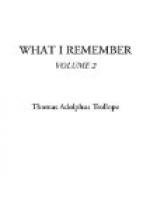The Sagro Eremo is inhabited by three classes of inmates; firstly, by novices, who are not permitted to come down to the comparative luxury and comfort and milder climate of the convent till they have passed three or four years at the Sagro Eremo. Secondly, by those who have been sent thither from the convent below as punishment for some misdoing. Thirdly, by those who remain there of their own free will, in the hope of meriting a higher and more distinguished reward for their austerities in a future life. One such was pointed out to us, who had never left the Eremo for more than fifty years, a tall, very gaunt, very meagre old man with white hair, hollow cheeks, and parchment skin, a nose like an eagle’s beak, and deep-set burning eyes—as typical a figure, in its way, as the rosy mountain of a man whom we met travelling down in his ox cart.
Lewes was always anxious lest George Eliot should over-tire herself. But she was insatiably interested both in the place and the denizens of it.
Then before supper at the forestieria was ready, our friend the father forestieraio insisted on showing us the growing crop of haricot beans, so celebrated for their excellence that some of them were annually sent to Pope Gregory the Sixteenth as long as he lived.
Then followed another night in the cow-house for George Eliot and for us in the convent, and the next morning we started with Antonio and his horses for La Vernia.
The ride thither from Camaldoli, though less difficult, is also less peculiar than that from Prato Vecchio to the latter monastery, at least, until La Vernia is nearly reached. The penna (Cornish, Pen; Cumbrian, Penrith; Spanish, Pena) on which the monastery is built is one of the numerous isolated rocky points which have given their names to the Pennine Alps and Apennines. The Penna de la Vernia rises very steeply from the rolling ground below, and towers above the traveller with its pyramidal point in very suggestive fashion. The well-wooded sides of the conical hill are diversified by emergent rocks, and the plume of trees on the summit seems to suggest a Latin rather than a Celtic significance for the “Penna.”
It is a long and tedious climb to the convent, but the picturesque beauty of the spot, the charm of the distant outlook, and above all the historical interest of the site, rewards the visitor’s toil abundantly. There is a forestieria here also, within the precincts of the convent, but not within the technical “cloister.” It is simply a room in which visitors of either sex may partake of such food as the poor Franciscans can furnish them, which is by no means such as the more well-to-do Carthusians of Camaldoli supply to their guests. Nor have the quarters set apart for the sleeping accommodation of male visitors within the cloister anything of the spacious old-world grandeur of the strangers’ suite of rooms at the latter monastery. The difficulty




